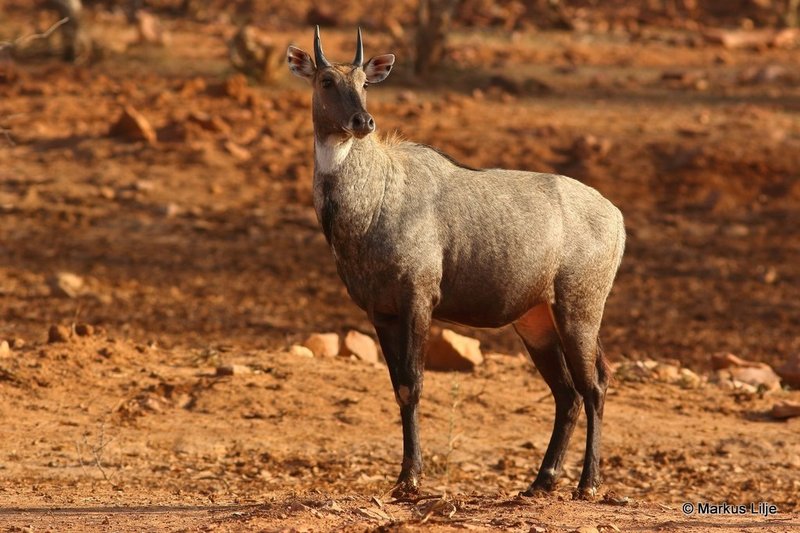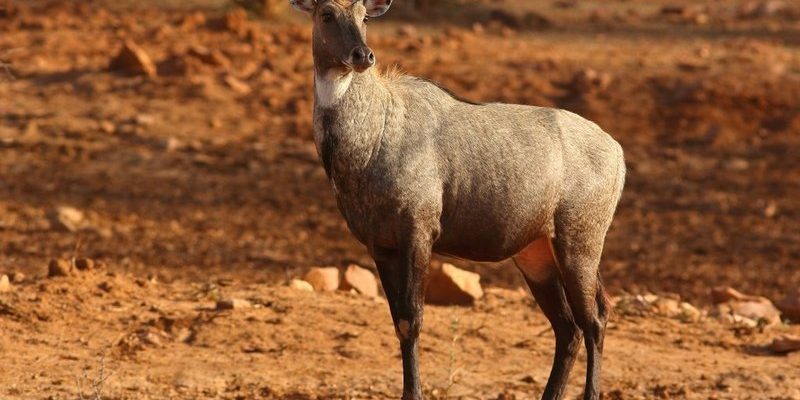
The Nilgai, also known as the blue bull, is a unique and captivating animal that roams the grasslands and scrub forests of the Indian subcontinent. Imagine a creature that stands tall and elegant, with a striking blue-gray coat and large, expressive eyes. This antelope is more than just a pretty face; it plays a crucial role in its ecosystem and has a rich cultural presence in India.
You might be wondering about its name. “Nilgai” comes from the Hindi words “nil,” meaning blue, and “gai,” meaning cow. This delightful mix of terms reflects its stunning color and its size, similar to that of a cow. These animals are remarkable for their adaptability, thriving in various habitats, from national parks to agricultural areas.
Physical Characteristics of Nilgai
When you see a Nilgai for the first time, its size and build may leave you in awe. Adult males typically weigh between 90 to 120 kilograms (around 200 to 265 pounds) and stand about 1.2 meters (4 feet) tall at the shoulder. Their sturdy legs and muscular bodies are designed for speed and endurance, allowing them to escape from predators like leopards and wild dogs.
The males sport a striking blue-gray coat, while females are usually a lighter brown. Both sexes have a white patch on their face and white markings on their legs, which help them blend into the grasslands. You can easily identify males by their large, curved horns, which can grow up to 80 centimeters (31 inches) long. This impressive feature adds to their majestic appearance, making them stand out in the wild.
Another interesting aspect of their appearance is the Nilgai’s unique resemblance to cattle. With their sturdy build and similar body shape, they often confuse onlookers. However, their elongated necks and distinctive features clearly set them apart, making them a fascinating sight in their natural habitat.
Habitat and Distribution
Nilgais are primarily found in the Indian subcontinent, thriving in a variety of habitats. They prefer grasslands, open forests, and scrubland but can also be spotted near agricultural fields, where they can graze on crops. This adaptability is a remarkable survival trait, allowing them to live in areas with varying climates and resources.
You may find Nilgais in national parks like Corbett and Ranthambore, where they roam freely and coexist with other wildlife. These regions provide ample food and cover, which is essential for their survival. However, as human activities continue to expand into their territories, Nilgais often venture into farmland, leading to conflicts with farmers.
Interestingly, Nilgais have a flexible social structure. They are usually found in small groups, which consist mostly of females and their young ones. Males tend to be solitary or form small bachelor groups, especially during the mating season. This dynamic allows them to maintain a balance within their populations while navigating the challenges of their environment.
Diet and Feeding Habits
Nilgais are herbivores and have a diverse diet that primarily consists of grasses, leaves, and shrubs. Depending on the season and availability, they adapt their feeding habits to make the most of the resources around them. This flexibility is crucial for their survival, especially during dry spells when food can be scarce.
Their grazing habits are fascinating to observe. Nilgais often use their strong, sharp incisors to nibble on grass, and they employ a unique technique called “selective feeding.” This means they choose only the most nutritious parts of plants, allowing them to thrive even in less-than-ideal conditions. This selective approach helps maintain the balance in their ecosystems, as it encourages the growth of new vegetation.
You might have noticed that Nilgais are also known to be quite picky eaters. They seem to have preferences for certain types of grass and plants, which varies based on their location and the time of year. This behavior not only aids in their survival but also showcases their adaptability in changing environments.
Behavior and Social Structure
The social structure of the Nilgai is intriguing and demonstrates their adaptability. As mentioned, females often form groups with their young, while males tend to live alone or in small bachelor herds. This dynamic helps them navigate their environment effectively, as group dynamics can provide safety against predators.
When it comes to communication, Nilgais are known to use a variety of vocalizations and body language. They often emit low grunts or snorts to alert other members of their group about potential dangers. Watching them interact can be quite fascinating, as they display a range of behaviors that show their social nature.
Nilgais are also known for their keen senses. Their large eyes provide excellent vision, allowing them to spot threats from a distance. Coupled with their acute sense of hearing, these traits make them exceptionally aware of their surroundings. This heightened awareness is crucial for avoiding predators and adapting to their ever-changing habitat.
Reproduction and Lifespan
When it comes to reproduction, Nilgais have a fascinating life cycle. Mating usually occurs during the monsoon season, between July and October. During this time, males engage in territorial displays, showcasing their size and strength to attract females. They can be quite competitive, leading to dramatic sparring matches between males as they vie for mating rights.
After a gestation period of around 7 to 8 months, females give birth to a single calf, although twins can occasionally occur. The young are born during the rainy season, which is advantageous since it allows for ample food availability. The calves are quite vulnerable at birth, relying on their mothers for protection and care.
In terms of lifespan, Nilgais can live for 10 to 15 years in the wild, and occasionally longer in captivity. Their life expectancy can be influenced by various factors, including predation, habitat availability, and food sources. This means their adaptability and social structures play an essential role in their survival and longevity.
Conservation Status
While Nilgais are not currently considered endangered, they face various threats that impact their populations. Habitat loss due to agricultural expansion and urban development poses a significant challenge. As human populations grow, Nilgais often find themselves pushed into smaller areas, leading to increased conflicts with farmers.
Conservation efforts are crucial to ensuring the survival of this remarkable species. Many wildlife organizations are working to create protected areas and maintain habitats so that Nilgais can thrive. These efforts are essential not only for the Nilgai but for the entire ecosystem, as they help maintain biodiversity and stability.
Moreover, education and awareness programs can play a vital role in fostering coexistence between Nilgais and local communities. By understanding the importance of this species and its role in the ecosystem, people can adopt more sustainable practices that benefit both wildlife and agricultural needs.
| Characteristic | Details |
|---|---|
| Common Name: | Nilgai (Blue Bull) |
| Scientific Name: | Boselaphus tragocamelus |
| Habitat: | Grasslands, open forests, scrubland |
| Diet: | Herbivore (grasses, leaves, shrubs) |
| Lifespan: | 10-15 years in the wild |
| Weight: | 90-120 kg (200-265 lbs) |
| Height: | 1.2 meters (4 feet) at shoulder |
FAQ
What is the habitat preference of Nilgai?
Nilgai prefer a mix of grasslands, scrub forests, and open agricultural areas. They thrive where vegetation is abundant, allowing them to graze comfortably. You can find them in places like national parks or even on the edges of farms, as they adapt well to different environments.
Are Nilgai solitary or social animals?
Nilgai exhibit both social and solitary behaviors. Females and their young often form small groups, while adult males tend to be more solitary or can form bachelor herds during non-breeding times. This mix allows them to stay safe while also minimizing competition among males.
How do Nilgai communicate with each other?
These animals have a rich communication system that includes vocalizations and body language. They often use grunts or snorts to alert others of danger and display physical cues, such as postures or movements, to signal their intentions or emotions. This communication is essential for maintaining social bonds and alerting the group to potential threats.
What is the breeding season for Nilgai?
Nilgai typically breed during the monsoon season, which is from July to October. During this time, males engage in courtship displays and compete for mating opportunities. This seasonal pattern aligns with the availability of food and resources, ensuring that calves are born when conditions are most favorable.
What do Nilgai eat?
Nilgai are herbivores and primarily graze on various grasses, leaves, and shrubs. They have a selective feeding habit, favoring the most nutritious parts of plants. This adaptability allows them to thrive even in changing environments, where food sources can fluctuate throughout the year.
How do Nilgai adapt to human encroachment?
As human activities encroach on their habitats, Nilgai have shown remarkable adaptability. They often venture into agricultural fields in search of food, which can lead to conflicts with farmers. Conservation efforts are focused on creating buffer zones and promoting coexistence to minimize these issues while allowing Nilgais to thrive.
What is the conservation status of Nilgai?
Nilgai are currently not classified as endangered, but they face threats from habitat loss and human-wildlife conflict. Conservation measures, including habitat protection and community education, are critical to ensuring their survival. Efforts are ongoing to maintain healthy populations and protect their natural environments.
How can I see Nilgai in the wild?
If you’re keen to spot Nilgai in the wild, visiting national parks in India, such as Corbett or Ranthambore, is your best bet. These parks provide protected environments where Nilgai roam freely. Early mornings or late afternoons are typically the best times for wildlife watching, as these animals are more active during cooler parts of the day.
Can Nilgai be kept in captivity?
While Nilgai can be kept in captivity, it is essential to provide them with ample space, appropriate vegetation, and social opportunities. They thrive in environments that mimic their natural habitats. However, it is crucial to adhere to local laws and regulations regarding wildlife captivity and conservation efforts.
What role do Nilgai play in their ecosystem?
Nilgai play a vital role in their ecosystem as herbivores, helping to maintain plant diversity by grazing on grasses and shrubs. Their feeding habits promote healthy vegetation growth, benefiting other wildlife in the area. Their presence contributes to the overall balance of the ecosystem, making them an important part of their natural habitat.

